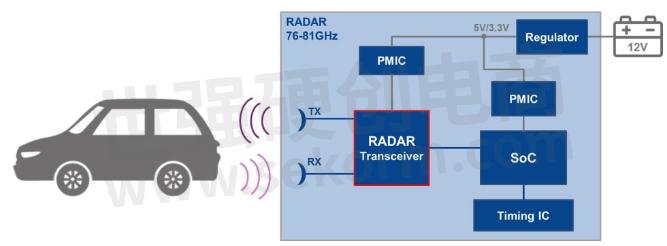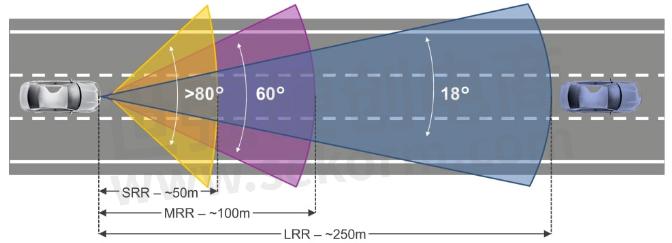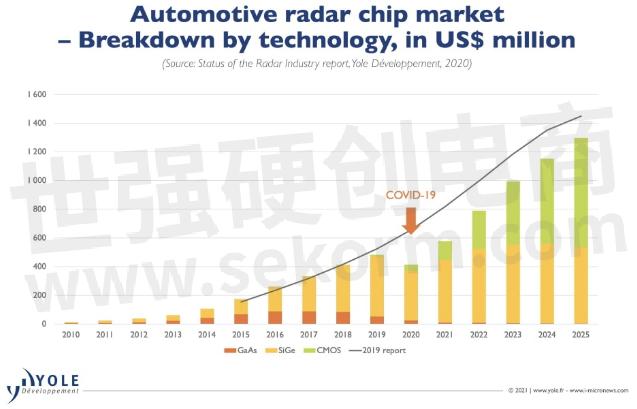Radar Transceivers: A Key Component for ADAS & Autonomous Driving




Communications and sensing technologies have transformed the automotive industry. More and more, cars include features and systems to interact with their environment, gaining awareness of the surrounding space, networking with each other and with the infrastructure, and detecting possible sources of danger. We can consider that vehicles have acquired their own“senses”: they know where they are, and can now see, hear and feel what happens around them.

Figure 1: Sensors, navigation, and communications: The“senses” of a car.
Automotive sensors are key to improve road traffic safety and reach levels 4 and 5 of autonomous driving. The use of advanced sensor technologies will allow preventing accidents through warning signals and automated safety functions, and thus reaching the Vision 0 objectives: 0 deaths in traffic accidents by 2050. In this sense, the European Parliament approved in 2019 a law making safety features such as intelligent speed assistance, advanced emergency-braking system, and lane-keeping systems compulsory for all new vehicles as from May 2022 for new models and as from May 2024 for existing models.
Also, safety measures have become increasingly important when buying a car. For this reason, the European New Car Assessment Programme (Euro NCAP) includes 2020 emergency braking systems in their evaluations. This has forced the industry to increase its efforts and include new detection features in its vehicles.
1. Automotive sensors for ADAS/AS
Different options are available for sensing the environment around a vehicle. Yet, for fully autonomous driving a combination of different sensing technologies will be required, be able to provide full 360° detection. The full system can be seen as the “senses” of a car, providing the means to interact with the surroundings and creating a safe “cocoon”. Each technology has its pros and cons, as listed in Table 1 below, so that fully autonomous driving requires the combination of different sources, as shown in Figure 2.
Table 1: Pros and cons of different sensor technologies for automotive applications


Figure 2: ADAS/AD system trend: integration of sensors.
2. Automotive radar
Radar is a well-known technology, which relies on sending and receiving electromagnetic waves to measure, detect and locate obstacles in the environment. Radar is specially indicated automotive applications, as vehicles are good reflectors for the electromagnetic waves, and thus their distance, position, and velocity can be determined accurately.
In automotive environments, Frequency Modulated Continuous Wave (FMCW) radar is used in different frequency bands, depending on the application. The principle of FMCW radar will be explained in the next radar blog entry. The basic topology of the radar is shown in Figure 3. It includes one or more radar MMIC transceivers, connected to a high-performance processing unit (MCU or SoC). The topology and number of chips will depend on the location of the radar module on the vehicle and the application it has to cover, as also shown in Figure 4.

Figure 3: Example of radar architecture.

Figure 4: Combinations for different radar applications.
The International Telecommunications Union (ITU) defines two categories of automotive radar systems, depending on their function:
· Category 1: It includes radar systems that provide comfort functions for the driver, enabling more stress-free driving. This category comprises adaptive cruise control (ACC) and collision avoidance (CA) radar, for measurement ranges up to 250 meters.
· Category 2: It defines sensors for high-resolution applications, which add to the passive and active safety of a vehicle, as for example blind-spot detection, lane-change assist, and rear-traffic-crossing-alert, detection of pedestrians and bicycles near a vehicle. The range is lower than Category 1, with a maximum of 50m to 100m, depending on the application. The purpose of these systems is to improve traffic safety by increasing the passive and active safety of a vehicle.
The types of radar can also be classified depending on the measurement range (Figure 5):
· Short Range Radar (SRR), with a large field of view and high resolution and a range of up to 50 m.
· Mid-Range Radar (MRR), with the medium field of view and range up to 100 m,
· Long Range Radar (LRR), which does not require high resolution or wide field of view, but aims to the highest possible range, up to 250m.

Figure 5: Typical range and Field of View for automotive radar.
To provide 360° coverage, different radar sensors with different functions need to be placed on the car, as in Figure 6. The obtained data must be combined to obtain real-time accurate information on the surroundings.

Figure 6: Placement of radar sensors on a car for 360° coverage.
Radar sensors can easily be installed behind common elements of the car, like bumpers or company emblems, so that they are invisible and do not affect the aesthetics. This integration gets easier with higher frequencies of operation, as the size of the antennas, which determines the size of the module, is linearly proportional to the wavelength, and thus inversely proportional to the operating frequency. There used to be four main frequency bands used in automotive radar systems, two in the K-band (around 24GHz) and two in the E-band (between 76 and 81GHz), as depicted in Figure 7.

Figure 7: Frequency bands for automotive radar.
However, the 24GHz bands are to be discontinued, due to interference with radio astronomy and earth exploration applications. As an alternative, the frequency band from 76 GHz to 81 GHz has been accepted by most countries as the frequency band for automotive radars. There, 1GHz bandwidth is reserved for LRR (76 to 77GHz), while 4 GHz bandwidth is available for applications requiring better resolution, as summarized in Table 2.
Table 2: Typical automotive radar characteristics in the frequency band 76-81 GHz, according to ITU Recommendation ITU-R M.2057-0

3. Radar market
The integration of new safety and comfort features in new vehicles has led to a surge in the radar market. Automotive is the fastest-growing segment of this market, expected to surpass US$10 billion in 2025, as shown in Figure 8.

Figure 8: Evolution of the radar market (Source: Yole Report 2020)
If we only consider the radar MMIC transceiver, the market forecast is more than US$1.2 billion, with GaAs technology almost disappearing and CMOS experiencing rapid growth to become the dominant technology by 2025.

Figure 9: Evolution of the radar MMIC market per technology (Source: Yole Report 2020)
4. Conclusion
Radar modules have become a standard feature in modern vehicles. While they have some disadvantages with respect to other technologies in terms of range resolution, their reliability and versatility make them irreplaceable parts in modern ADAS/AD systems. The shift to higher frequencies from 76 to 81 GHz has brought new technological challenges but makes this an exciting field for new developments by the semiconductor sector.
- |
- +1 赞 0
- 收藏
- 评论 0
本文由董慧转载自Renesas,原文标题为:Radar transceivers: a key component for ADAS & Autonomous Driving - Blog 1: Why do we need radar?,本站所有转载文章系出于传递更多信息之目的,且明确注明来源,不希望被转载的媒体或个人可与我们联系,我们将立即进行删除处理。
相关推荐
Rohm Automotive Lighting Solutions Will Focus on the ADAS Space and Autonomous Driving Systems
LED technology has brought with it several breakthroughs that address design limitations of the lamp unit to achieve a variety of form factors, from thin, compact types to unique packages specific to individual car manufacturers. These specially designed lamp modules utilizing multiple LEDs add new features and functions not available with conventional lighting systems.
5G Cellular Routers Empowering the Development of Autonomous Driving Technology
With the rapid development of technology, autonomous driving technology has become a star in the field of intelligent transportation, and the connected vehicle ecosystem, as a bridge for information exchange between vehicles, roads, and pedestrians, is crucial for the widespread application of autonomous driving technology. In this context, the emergence of 5g cellular router has injected new vitality into the development of autonomous driving technology, providing a more efficient and secure wireless application solution for the connected vehicle ecosystem.
地平线携征程系列智能驾驶计算方案ADAS及高阶智能驾驶场景软硬件解决方案亮相IAA MOBILITY
2023 IAA MOBILITY正式开幕,地平线全程参展。作为行业领先的高效能智能驾驶计算方案提供商,此次地平线全面展示了品牌发展理念与历程、征程系列智能驾驶计算方案、ADAS及高阶智能驾驶场景软硬件解决方案,以及最新的商业生态量产合作成果。站在2023 IAA MOBILITY这一国际领先的移动出行平台,地平线充分展示“以人为本”智能驾驶计算方案的魅力,助推技术应用普惠。
FS6500、FS4500安全电源系统基本芯片,带CAN FD和LIN收发器短数据表:高级信息
型号- MC32FS6510LAE,MC33FS4503CAE,MC32FS6510NAE,MC33FS6503NAE,MC33FS6522LAE,MC33FS652CCAE,MC33FS6501CAE,MC33FS4501NAE,MC33FS6520CAE,MC33FS6513NAE,FS4500,MC32FS6512CAE,MC33FS6522NAE,MC33FS6511CAE,MC33FS4502CAE,MC33FS6502LAE,MC33FS6502NAE,MC33FS6523NAE,FS6500L,MC33FS6500CAE,MC33FS4500LAE,MC33FS4500NAE,MC33FS6521CAE,MC33FS6512LAE,MC33FS6512NAE,MC33FS450GNAE,MC33FS6510CAE,MC33FS450GLAE,MC33FS4501CAE,MC33FS6501NAE,MC32FS6512NAE,MC33FS652GNAE,MC33FS652GLAE,MC33FS4503NAE,MC32FS6502NAE,MC33FS6511NAE,MC33FS6522CAE,MC33FS6503CAE,FS6500,MC32FS6510CAE,MC33FS6520LAE,MC33FS6520NAE,MC33FS6513CAE,FS6500C,MC33FS650GLAE,MC33FS6500LAE,MC33FS4500CAE,MC33FS6504LAE,MC33FS6510NAE,MC33FS4502LAE,MC33FS4502NAE,MC33FS650GNAE,MC33FS6502CAE,MC33FS6523CAE,MC32FS6522NAE,MC33FS6510LAE,MC32FS4502NAE,MC33FS6514LAE,MC33FS6521NAE,MC33FS450CCAE,FS4500C,MC33FS6500NAE,MC33FS6512CAE
FS6500、FS4500:带CAN FD和Lin收发器的ASIL B安全电源系统基本芯片产品简介
型号- MC33FS6518CAE,MC33FS4505LAE,MC33FS4507KAE,MC33FS6505KAE,MC33FS6526NAE,MC33FS4505NAE,MC33FS6508CAE,MC33FS6505CAE,FS4500,MC33FS6515KAE,MC33FS6517NAE,MC33FS6517LAE,MC33FS6507LAE,MC33FS6507NAE,MC33FS6515CAE,MC33FS4506CAE,MC33FS6517CAE,MC33FS6525KAE,MC33FS4508NAE,MC33FS6506NAE,MC33FS6527LAE,MC33FS6527NAE,MC33FS6525CAE,MC33FS6507CAE,MC33FS6528CAE,MC33FS6516NAE,MC33FS4505CAE,MC33FS C 5 XYZ AE/R2,MC33FS4505KAE,MC33FS4507NAE,MC33FS6505NAE,MC33FS4507LAE,MC33FS6505LAE,MC33FS6528NAE,MC33FS6526CAE,MC33FS6506CAE,MC33FS6515NAE,FS6500,MC33FS6507KAE,MC33FS6515LAE,MC33FS6517KAE,MC33FS4508CAE,MC33FS6525LAE,MC33FS6527KAE,MC33FS6525NAE,MC33FS4506NAE,MC33FS6527CAE,MC33FS,MC33FS6518NAE,MC33FS6508NAE,MC33FS6516CAE,MC33FS4507CAE
易于访问的宣传资料目录
型号- ANALOGPAK™,RH850 P,RX,RZN,RH850 D,HVPAK™,RT SERIES,RH850 F,RN SERIES,RS-232,RH850 U,GREENPAK™,RH850 C1MA SERIES,RZ SERIES,RA SERIES,RZN SERIES,RG SERIES,RH850E SERIES,RS-485,RH850 P SERIES,RH850E,RH850,RH850 F SERIES,RH850 C1MA,RH850 U SERIES,RH850 D SERIES,RS-422,RL78
S32R雷达MCU–适用于高分辨率雷达的高性能:S32R41
描述- S32R41是一款针对高级77GHz雷达应用定制的雷达微处理器单元(MPU)。该架构采用Arm Cortex-A53和Cortex-M7核心,结合雷达处理加速器(SPT和BBE),以实现最佳的雷达处理链。它旨在针对ADAS雷达市场,同时也适用于工业和消费级雷达应用。S32R41的高性能处理与双MIPI CSI接口和8MB本地SRAM相结合,支持4D高分辨率雷达系统。该处理器还适用于高级角雷达和长距离前雷达应用。S32R41的架构是NXP可扩展雷达产品组合的一部分,与S32R45 4D成像雷达处理器共享相同的软件产品目录。S32R41与NXP TEF82xx 77GHz雷达收发器配合使用,为高分辨率和成像雷达市场提供可扩展的解决方案。
型号- TEF82XX,S32R41,S32R41 FAMILY,S32R45
Radar transceivers: a key component for ADAS & Autonomous Driving-Basics of FMCW radar
This entry has provided an overview of the operating principle of the FMCW radar, used in automotive applications, and its implementation using MMICs and MCU/SoC.
Antennas for Automotive Radar
In previous issues of the radar blog, we have reviewed the main characteristics of MMIC transceivers for automotive radar. Yet, an aspect still needs to be covered: how to integrate the MMIC on the radar module’s PCB, and what should we consider to optimize the interface between the chip and the antennas.
Renesas Unveils RAA270205, the First 4x4-channel 76-81GHz Automotive Radar Transceiver with High Accuracy and Low Power Consumption
Renesas is entering the automotive radar market with the introduction of a 4x4-channel, 76-81GHz transceiver designed to meet the demanding requirements of ADAS and Level 3 and higher autonomous driving applications. It will be available in 1Q/2023 in sample quantities, with commercial production planned for 2024.
IAM-20685用于ADAS和自动驾驶应用的汽车6轴MotionTracking®MEMS器件
描述- IAM-20685是一款集成了3轴陀螺仪和3轴加速度计的6轴运动跟踪MEMS器件,适用于ADAS(高级驾驶辅助系统)和自动驾驶应用。该器件具有小型化设计,尺寸为4.5x4.5x1.1mm³,支持可编程的全量程范围,并具备高可靠性和安全性。
型号- IAM-20685
LX Semicon电机驱动器&MCU选型表
LX Semicon电机驱动器&MCU选型表包含32位通用MCU、2ch H-桥电机驱动器、三相电机驱动器三个品类,主要包含以下参数,Operating Temperature(℃):-40℃ ~ 85℃;Power (V):3.9 to 5.5V、2.7 to 5.5V、Max.20V、Max.28V;competitor:Toshiba、Renesas、TI。
|
产品型号
|
品类
|
封装/外壳/尺寸
|
Power (V)
|
Grade certification standard
|
competitor
|
External High Speed OSC(MHz)
|
External Low Speed OSC(KHz)
|
Operating Temperature(℃)
|
Maximum Frequency(MHz)
|
SRAM(Kbyte)
|
|
SW31100
|
32位通用MCU
|
LQFP 64
(10*10, 0.5pitch)
|
3.9 to 5.5V
|
IEC 60730 supported
|
Toshiba
|
10MHz
|
32.768kHz
|
-40℃ ~ 85℃
|
35MHZ
|
12 Kbyte
|
选型表 - LX Semicon 立即选型
REF66012 – 参考设计 ADAS SoC用 PMIC解决方案
描述- 本资料介绍了ROHM公司为ADAS SoC设计的PMIC(电源管理集成电路)解决方案。方案包括BD96801Q09-CE2四通道DC-DC转换器和BD9S303MUF-CE23A同步降压转换器,旨在提供高效率和高可靠性。该方案适用于智能前视摄像头(IFC),集成200万像素摄像头和多毫米波雷达,支持L2级前向ADAS功能。它采用Horizon Journey2芯片和Infineon TRAVEO II系列CYT4BF微控制器,实现AEB、ACC等功能。此外,还提供了详细的规格和应用说明。
型号- BD96801Q09-CE2,BD9S303,BD9S303MUF-CE2,BD96801Q09,BD96801,BD9S303MUF
【产品】低功耗全高清ADAS专用低功耗SoC芯片SGKS6802
森国科SGKS6802是一款针对高级辅助驾驶(ADAS)、流媒体后视镜、夜视系统、透雾透霾及图形图像识别与处理等产品开发的ADAS专用低功耗SoC芯片,1080P@30fps+720P@30fps双路码流H.264编码及高质量的ISP处理。
电子商城
现货市场



































































































































































































登录 | 立即注册
提交评论